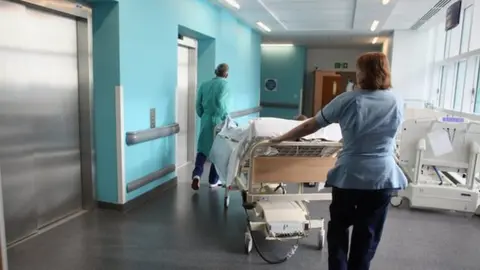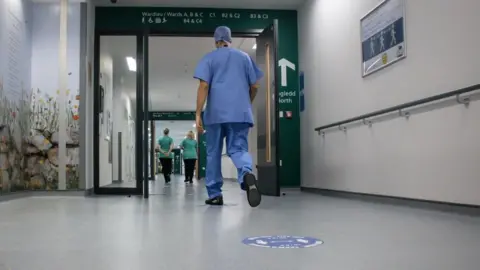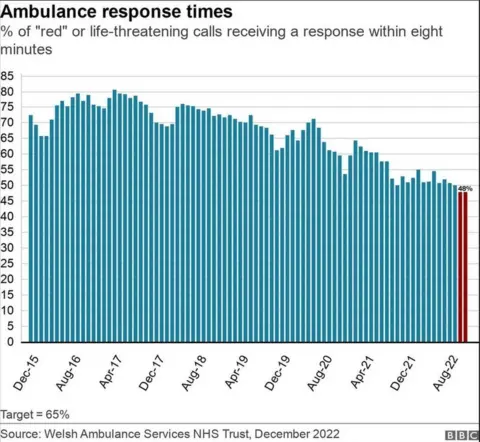NHS waiting times: First drop in Wales since pandemic
 Getty Images
Getty ImagesThe waiting list for planned treatments in the Welsh NHS has decreased for the first time since the start of the pandemic.
October figures show there were 753,293 treatments waiting to be completed - a drop of 0.2% from September.
This is the first decrease since April 2020.
But this is still the second highest number recorded, and 62.6% higher than at the start of the pandemic in February 2020.
The figures also show performance of Welsh A&Es improved slightly in November, despite immense pressures on health and care service.
Separate figures also show a rise in patients being treated in hospital for acute respiratory infections - winter illnesses including flu, Covid and respiratory syncytial virus.
These now make up 11% of patients in hospital - up from just over 3% a couple of weeks ago.
During October, the ambulance service recorded its joint worst performance for response times to the most serious calls and waiting times for cancer treatment were also the worst on record.
"Unfortunately, we are seeing out 2022 in the same way as we started it back in January, with a dire warning that delays in cancer care are worse than ever before," said Macmillan Cancer Support's policy manager Glenn Page.
"That warning has been repeated throughout a year in which the coronavirus crisis has quickly been overtaken by a crisis in cancer care itself."
He said the "direction of travel must be reversed in 2023".

Analysis by BBC Wales Health Correspondent Owain Clarke
After growing for two-and-a-half years, the fact that the waiting list has begun to shrink, albeit ever so slightly, is significant.
Yet there are still more that 750,000 treatments waiting to be completed and almost 55,000 have waited more than two years.
A backlog of that scale would have seemed unimaginable before the pandemic.
There is another small ray of light for the NHS and Welsh government in the fact that A&E performance improved slightly last month... but it's a bleaker picture in terms of cancer care.
Despite more people with suspected cancer being seen than ever before, a smaller proportion are being seen within the target time of 62 days.
But all of these figures illustrate what the position was before nurses and ambulance workers took industrial action this month
So any gains and improvements illustrated in today's statistics may well be wiped out as a result of that, as well as the phenomenal pressure the NHS has been under in December.

Welsh Conservative health spokesman Russell George said: "Is it at all surprising to see doctors consider striking alongside nurses, ambulance workers, and midwives in Labour-run Wales when we see numbers like this?
"This cost-of-pain crisis is a living nightmare for those forced to wait months, if not years for treatment, while patients are scared about whether they will get an ambulance or not, or whether they will be seen in A&E in a reasonable time."
Plaid Cymru health spokesman Rhun ap Iorwerth called for the Welsh government to "wake up" and take the "radical action" to address the "long-standing issues" in the NHS in Wales.
"Our NHS is at breaking point and something has to give," he added.
"There have been long-standing problems with patient flow through hospitals, and with increased pressure on our emergency service and more and more patients being added to waiting lists, our hard-working staff have given everything they can."
All the figures reflect the position before the industrial action by nurses and ambulance workers this month, which is likely to have had a large impact on both waiting times and urgent care.
Waiting times
There were more than 753,000 patient pathways waiting to start treatment in October - a decrease of 0.2% from just under 755,000 in the previous month.
However, 177,000 people were waiting more than one year in October.
Also, almost 55,000 had been waiting more than two years, following a seventh consecutive monthly fall after a consistent increase over the previous year.
The Welsh government set a target of eliminating waits of more than two years by the end of this year.
Waiting times figures published in February will reflect the year-end position.
Accident and emergency
 Getty Images
Getty ImagesThe figures for November show that 67.3% of patients in all NHS emergency departments spent less than four hours there.
This was 0.7 percentage points higher than October, but is still significantly lower than performance before the pandemic.
The worst performance against the target of seeing 95% of A&E patients within four hours was at Glan Clwyd Hospital, Denbighshire, where it was 48.6%.
There was also an improvement in the numbers of patients waiting more than 12 hours in these departments.
In November, there were 10,053 patients waiting 12 hours or more.
This was 972 (8.8%) fewer than in the previous month. However, Welsh government targets state nobody should be waiting this long.
Ambulances

The figures show the Welsh Ambulance Service continued to struggle during November.
During the month, 48% of emergency responses to immediately life threatening (red) calls arrived within eight minutes.
This was the same level as the previous month, the joint lowest on record, and 5% lower than in November 2021.
Cancer
Figures show in October, 52.2% (884 out of 1,694) of cases started their first definitive treatment within 62 days of first being suspected of cancer.
The target is 75%, which is due to be raised to 80% by 2026.
This was 1.1% lower than the previous month, eight percentage points lower than October 2021 and is the lowest figure since December 2020, when the target was introduced.
Less than half of patients with suspected cancer started treatment within the target time in Hywel Dda (41%) and Cwm Taf Morgannwg (44%) health boards.
It means 810 patients in Wales were still waiting to start cancer treatment in October, two months after it was first suspected.
